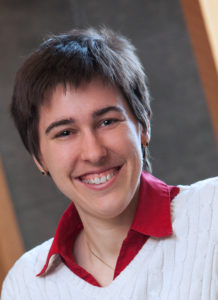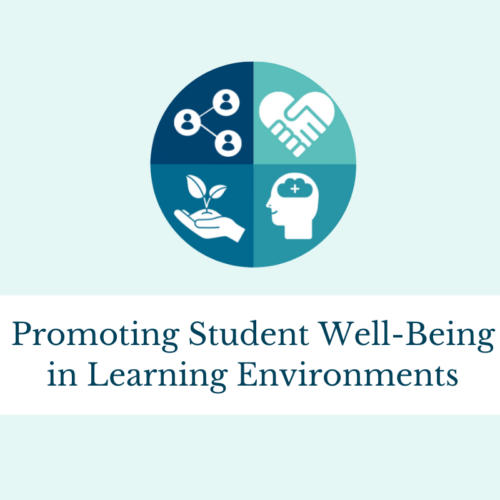Faculty Spotlight with Patricia Weisensee, Assistant Professor of Mechanical Engineering & Materials Science
 “No one is born a master; the more we practice, the better we get. That’s true for almost everything in life, and teaching is no exception to that rule,” said Patricia Weisensee, Assistant Professor of Mechanical Engineering & Materials Science in the McKelvey School of Engineering at Washington University in St. Louis. Professor Weisensee teaches courses at WashU including “Design of Thermal Systems” for undergraduate students and “Solar Energy Thermal Processes” for graduate students.
“No one is born a master; the more we practice, the better we get. That’s true for almost everything in life, and teaching is no exception to that rule,” said Patricia Weisensee, Assistant Professor of Mechanical Engineering & Materials Science in the McKelvey School of Engineering at Washington University in St. Louis. Professor Weisensee teaches courses at WashU including “Design of Thermal Systems” for undergraduate students and “Solar Energy Thermal Processes” for graduate students.
Professor Weisensee earned a “Diplom-Ingenieur” (B.S. + M.S.) in Mechanical Engineering and graduated with high distinction from Technical University Munich. For her thesis work on condensing steam bubbles in subcooled flowing water, she was awarded the Siemens Energy Award, and she was a fellow of the German National Academic Foundation (Studienstiftung des Deutschen Volkes). Dr. Weisensee also obtained an M.S. in Materials Science and Engineering with a Certificate in Energy and Sustainability Engineering from the University of Illinois, Urbana-Champaign, while participating in an exchange program at Technical University Munich.
Professor Weisensee earned a PhD in Mechanical Science and Engineering from the University of Illinois, Urbana-Champaign, in 2016. She accepted a position as assistant professor at the McKelvey School at WashU in 2017.
In 2020, Professor Weisensee was an honoree of the Emerson Excellence in Teaching Award, which recognizes educators for their leadership in and passion for teaching, their contributions to student learning, and their knowledge and creativity.
In an interview with the Center for Teaching and Learning, Professor Weisensee highlighted the importance of practical applications of work in engineering studies. She described the “sanity check” at the end of her assignments, which gives students an opportunity to reflect on their answer based on readings, logic, or alternative calculations.
Professor Weisensee also elaborated on her time as a student in Germany, which influenced her as a researcher and educator.
What was your path toward becoming an engineering professor?
I always loved building things. My grandfather had a workshop in his basement, so every summer we would work on fun wood projects. In high school, I was good in math and physics, making engineering a natural choice for a university major. Even early on, I always joked that I’d become a professor, but that – I think – was mostly due to their status, since I didn’t really know what it meant to be a professor. I started undergraduate research as a sophomore, and really enjoyed digging into a specific project and making new discoveries. After an internship in industry, which felt somewhat boring to me, I realized that I’d stay in academia and get a doctorate. While working on my PhD, I was playing with the idea of joining a company upon graduation and doing industrial R&D. I soon realized, though, that the science was more interesting to me than the applied research I’d have found in industry. I also enjoyed teaching, so becoming a professor was the logical consequence.
What was your experience like in Germany? What did you take away from the experience?
University in Germany is structured very differently than it is here in the US. First, admissions are almost solely based on your GPA from high school, meaning we were close to 1,200 freshmen in mechanical engineering alone (which also has to do with university being free to attend). I was the last class to enter on a traditional “Diplom-Ingenieur” before the B.S. and M.S. system was introduced. The first two years were really meant to “weed out” students; by the time I graduated we were roughly 350 students who remained in the program. Because of the large class sizes, there is no way of forming relationships with professors. It also means that there is one big final exam (which usually had that many questions that it was impossible to finish; even for someone like me who was fairly fast at solving problems), with basically no midterms, graded homework, etc (would have been too much grading to do). Class attendance was not required (except for lab courses), meaning students were responsible for their time management more than what they are here in the US. While I prefer the option to work towards your final grade throughout the entire semester, i.e. have more but lower stakes assignments and exams, I do like the German approach of placing more emphasis on student independence and the ability to self-teach (which is an important skill beyond college). I am trying to incorporate some of that idea into my undergraduate class by giving open-ended assignments in which students have to find and define their own boundary conditions and assumptions. I believe that this approach prepares them better for their job upon graduation.
Tell me more about your thermal fluids research group WashU. What projects are you working on, and how do you guide students and lab members in this research?
We are a primarily experimental research group, meaning we use different imaging techniques to understand the physics behind different thermal-fluidic phenomena. Currently the focus of my research lies on “droplets”; how they interact with solid surfaces, with each other, during phase change (i.e., evaporation, condensation), and how we can use them to make heat transfer and thermal management more efficient. For example, we currently have a project with NASA in which we are developing a thermal switch that can passively turn on and off the flow of heat (similar to an electrical switch, which turns on and off the flow of electrons = current), depending only on the environmental temperature.
Similar to what I described above, I try to place a lot of emphasis on the independence of students; PhD students, but also undergraduate researchers who join my lab. We do have weekly meetings, but I try not to micro-manage and encourage my students to develop their own ideas, learn how to ask the right scientific questions, and come up with experimental methods of answering those questions.
What are some of the challenges of teaching engineering, and how do you address them?
One of the biggest challenge of engineering education, in my opinion, is the difficulty in teaching the physical fundamentals while at the same time showing a clear path for practical applications. We often tend to get stuck with too academic example problems. Along those lines comes the challenge I have alluded to earlier: finding and defining boundary conditions, not being afraid of making assumptions, knowing when the number you calculated is reasonable. Most textbook problem statements give exactly the parameters that the student needs to solve the problem, not too many (i.e., no additional, potentially misleading) variables, and not too few (i.e., no need for additional assumptions and/or literature research). However, that’s not what awaits students in their jobs (neither in industry, nor in academia), where we never know all variables, parameters, operating conditions, etc. This is where my “design homework” come into play: students have to do all of the above. There isn’t one right answer, which also means it’s important to have a “sanity check” at the end of an assignment, where students discuss whether their answer makes sense or not, based on readings, logic, alternative calculations, etc. Many students struggle the first time they come across a design homework, but it’s great to see that towards the end of the semester, many students appreciate and embrace this type of homework, as they realize that it prepares them better for life after graduation than many traditional textbook homework sets.
How have you adapted your teaching during the pandemic? What advice do you have for other instructors teaching during this challenging time?
In the Spring semester, when I was teaching my core undergraduate course, I was relatively lucky (compared to many colleagues) in that I didn’t have to change my course too much. I was already teaching in a flipped classroom approach and had all lecture videos with the theory prerecorded. In-class time was used solely for Q&A and group work to solve example problems. We simply moved these into breakout rooms on zoom, which worked OK, but definitely wasn’t the same experience as in-person. For Spring 2021, there are a few minor tweaks here and there, but overall I think this class is one that lends itself reasonably well to hybrid instruction, simply based on how I have been teaching it in the past. I am also fortunate that my Fall semester class is at the graduate level and relatively small, so that I could move it fully online. I again pre-recorded the theory, and we are meeting synchronously via zoom once a week for a recitation (problem solving) session. Most students have their video on and just unmute when they want to ask a question. Of course – again – interactions are more genuine in the classroom, but I believe the structure works reasonably well and makes sure everyone stays safe and healthy. Since all classes and class structures are so different, I don’t think I can give a lot of advice to other instructors. My only suggestion would be to be highly organized, use Canvas modules to structure the class, and to communicate regularly with the students to make sure they know what you are expecting when and how.
What do you hope students take away from your classes or lab?
The ability to work and learn independently, to critically evaluate their work, and to be open minded for new challenges and opportunities.
What advice do you have for aspiring instructors?
No one is born a master; the more we practice, the better we get. That’s true for almost everything in life, and teaching is no exception to that rule. I recommend starting early and small; first tutoring, then TA-ing and running recitation and help sessions, and in grad school substituting for the professor for individual lectures (designed by the aspiring instructor; talk to your advisor or mentor about giving you this opportunity). I also recommend attending workshops on teaching, reading literature and exchanging thoughts with (fellow) instructors on best education practices, and always being open to trying new things in the classroom. It’s like an experiment: sometimes new approaches work out great, and sometimes they don’t. Actively listen to the (constructive) feedback that students give and make small changes here and there, until you and your students are satisfied with the outcome.




